Analyzing the key trends shaping on-chain stablecoin yields, covering institutional adoption, infrastructure development, user behavior evolution, and the rise of yield stacking strategies.
Written by: Artemis & Vaults.fyi
Translated by: Felix, PANews (excerpt)
The DeFi stablecoin yield landscape is undergoing a profound transformation. A more mature, resilient, and institutionally aligned ecosystem is emerging, marking a significant shift in the nature of on-chain yields. This report combines insights from vaults.fyi and Artemis.xyz to analyze the key trends shaping on-chain stablecoin yields, covering institutional adoption, infrastructure development, user behavior evolution, and the rise of yield stacking strategies.
Institutional Adoption of DeFi: A Quiet Surge
Even as the nominal DeFi yields of assets like stablecoins have adjusted relative to traditional markets, institutional interest in on-chain infrastructure is steadily growing. Protocols like Aave, Morpho, and Euler are attracting attention and usage. This participation is driven more by the unique advantages of composable and transparent financial infrastructure rather than merely the pursuit of the absolute highest annualized yield, and these advantages are now further reinforced by continuously improving risk management tools. These platforms are not just yield platforms; they are evolving into modular financial networks and rapidly achieving institutionalization.
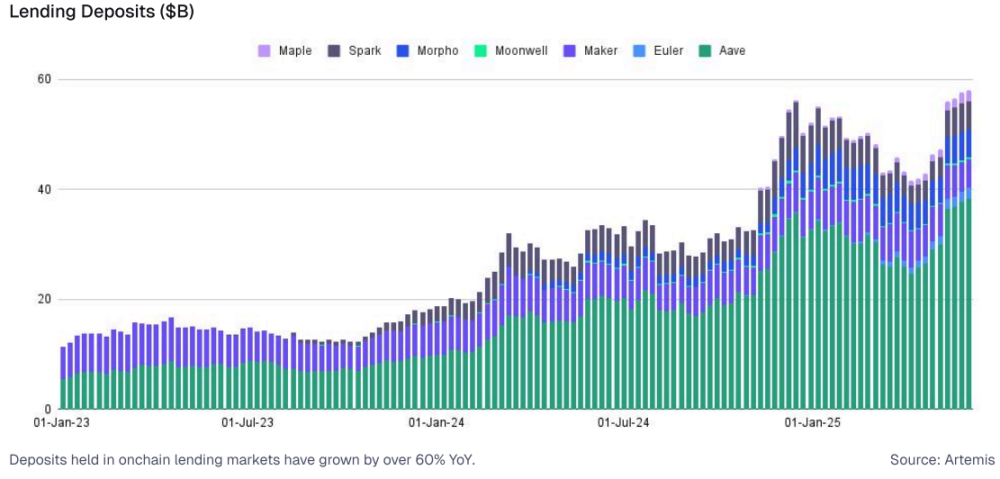
As of June 2025, the total value locked (TVL) in collateralized lending platforms like Aave, Spark, and Morpho exceeds $50 billion. On these platforms, the 30-day lending yield for USDC ranges from 4% to 9%, generally at or above the yield level of approximately 4.3% for 3-month U.S. Treasury bonds during the same period. Institutional capital is still exploring and integrating these DeFi protocols. Their enduring appeal lies in unique advantages: a 24/7 global market, composable smart contracts supporting automated strategies, and higher capital efficiency.
The Rise of Crypto-Native Asset Management Firms: A new class of "crypto-native" asset management firms is emerging, such as Re7, Gauntlet, and Steakhouse Financial. Since January 2025, the on-chain capital base in this sector has grown from about $1 billion to over $4 billion. These management firms are deeply engaged in the on-chain ecosystem, quietly deploying funds into various investment opportunities, including advanced stablecoin strategies. In the Morpho protocol alone, the total locked value (TVL) of major asset management firms is approaching $2 billion. By introducing specialized capital allocation frameworks and actively adjusting the risk parameters of DeFi protocols, they are striving to become the next generation of leading asset management firms.
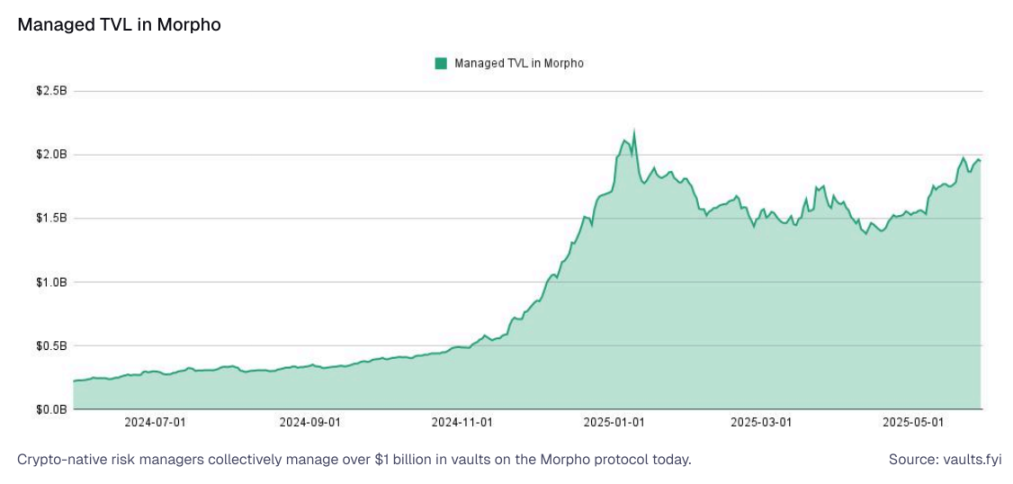
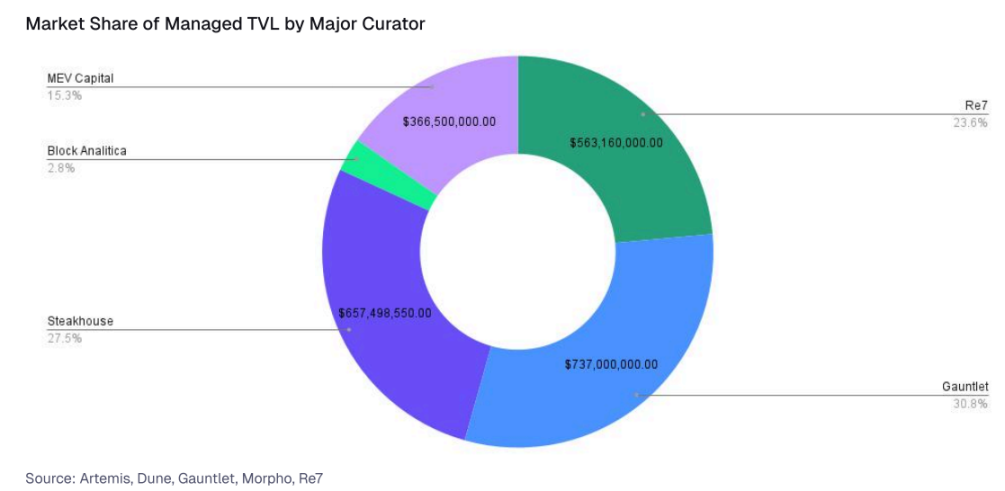
The competitive landscape among these native crypto asset management firms is beginning to take shape, with Gauntlet and Steakhouse Financial controlling approximately 31% and 27% of the custodial TVL market, respectively, while Re7 holds nearly 23% and MEV Capital accounts for 15.4%.
Regulatory Attitude Shift: As DeFi infrastructure matures, institutional attitudes are gradually shifting to view DeFi as a configurable supplementary financial layer rather than a disruptive, unregulated domain. Permissioned markets built on Euler, Morpho, and Aave reflect proactive efforts to meet institutional needs. These developments enable institutions to participate in on-chain markets while satisfying internal and external compliance requirements, particularly around KYC, AML, and counterparty risk.
DeFi Infrastructure: The Foundation of Stablecoin Yields
Today, the most significant advancements in the DeFi space are concentrated in infrastructure development. From tokenized RWA markets to modular lending protocols, a new DeFi stack is emerging—capable of serving fintech companies, custodians, and DAOs.
1. Collateralized Lending: This is one of the primary sources of yield, where users lend stablecoins (such as USDC, USDT, DAI) to borrowers, who provide other crypto assets (like ETH or BTC) as collateral, typically using over-collateralization. Lenders earn interest paid by borrowers, thus laying the foundation for stablecoin yields.
- Aave, Compound, and MakerDAO (now rebranded as Sky Protocol) have launched pool lending and dynamic interest rate models. Maker introduced DAI, while Aave and Compound built scalable money markets.
- Recently, Morpho and Euler have transitioned to modular and isolated lending markets. Morpho has introduced fully modular lending primitives, dividing the market into configurable vaults that allow protocols or asset managers to define their own parameters. Euler v2 supports isolated lending pairs and is equipped with advanced risk tools, showing significant momentum since the protocol's relaunch in 2024.
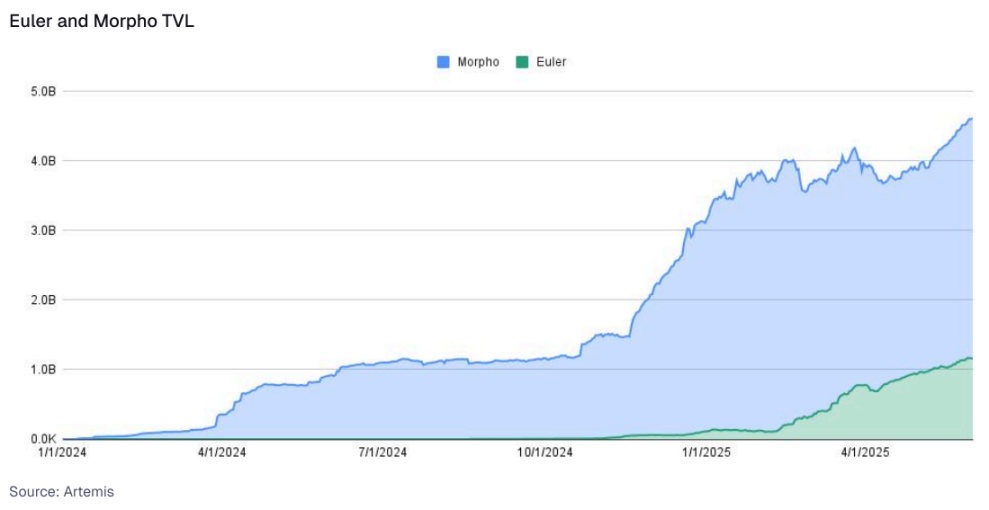
2. Tokenized RWA: This involves bringing the yields of traditional off-chain assets (especially U.S. Treasury bonds) into the blockchain network in the form of tokenized assets. These tokenized Treasuries can be held directly or integrated as collateral into other DeFi protocols.
- Tokenizing U.S. Treasuries through platforms like Securitize, Ondo Finance, and Franklin Templeton transforms traditional fixed income into programmable on-chain components. On-chain U.S. Treasuries have surged from $4 billion at the beginning of 2025 to over $7 billion by June 2025. As tokenized Treasury products are adopted and integrated into the ecosystem, they bring a new audience to DeFi.
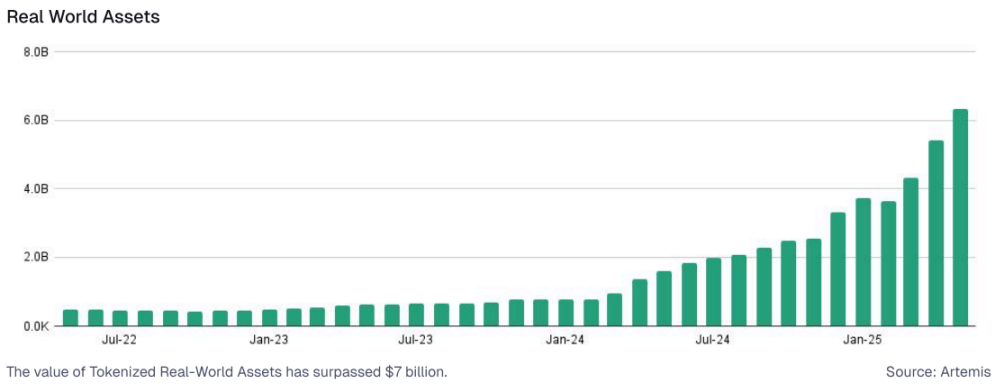
3. Tokenized Strategies (including Delta-Neutral and Yield-Generating Stablecoins): This category encompasses more complex on-chain strategies, often paying yields in the form of stablecoins. These strategies may include arbitrage opportunities, market-making activities, or structured products designed to generate returns for stablecoin capital while maintaining market neutrality.
- Yield-generating stablecoins: Protocols like Ethena (sUSDe), Level (slvlUSD), Falcon Finance (sUSDf), and Resolv (stUSR) are innovating stablecoins with native yield mechanisms. For example, Ethena's sUSDe generates yield through "cash and arbitrage" trading, shorting ETH perpetual contracts while holding spot ETH, with funding rates and staking yields providing returns to stakers. In recent months, some yield-generating stablecoins have yielded over 8%.

4. Yield Trading Markets: Yield trading introduces a novel primitive that separates future yield streams from principal, allowing floating-rate instruments to be split into tradable fixed and floating components. This development adds depth to DeFi financial instruments, aligning on-chain markets more closely with traditional fixed income structures. By turning yields themselves into tradable assets, these systems provide users with greater flexibility to manage interest rate risk and yield allocation.
- Pendle is a leading protocol in this field, allowing users to tokenize yield-bearing assets into principal tokens (PT) and yield tokens (YT). PT holders earn fixed returns by purchasing discounted principal, while YT holders speculate on variable returns. As of June 2025, Pendle's TVL exceeds $4 billion, primarily composed of yield-generating stablecoins like Ethena sUSDe.
Overall, these primitives form the foundation of today's DeFi infrastructure, serving a variety of use cases for crypto-native users and traditional financial applications.
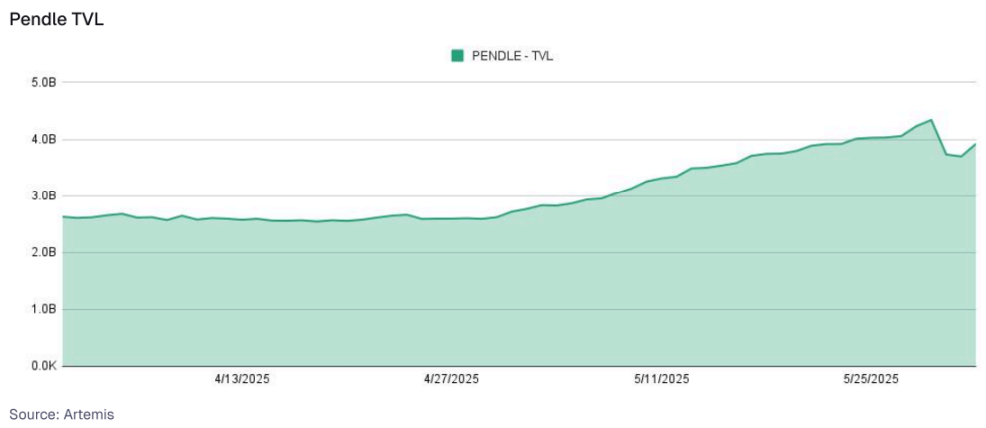
Composability: Stacking and Amplifying Stablecoin Yields
The "money Legos" characteristic of DeFi is manifested through composability, where the primitives used to generate stablecoin yields become the building blocks for constructing more complex strategies and products. This compositional approach can enhance yields, diversify (or concentrate) risks, and customize financial solutions, all centered around stablecoin capital.
Lending Markets for Yield Assets: Tokenized RWA or tokenized strategy tokens (like sUSDe or stUSR) can serve as collateral in new types of lending markets. This allows:
- Holders of these yield assets to borrow stablecoins against them, thereby unlocking liquidity.
- The creation of lending markets specifically for these assets, where holders can lend stablecoins to those looking to borrow against their yield positions, further generating stablecoin yields.
Integrating Diverse Yield Sources into Stablecoin Strategies: While the ultimate goal is often stablecoin-dominated yields, the strategies to achieve this can incorporate other areas of DeFi, managing carefully to produce stablecoin yields. Delta-neutral strategies involving lending non-USD tokens (such as liquid staking tokens LST or liquidity re-staking tokens LRT) can be structured to generate yields denominated in stablecoins.
Leverage Yield Strategies: Similar to arbitrage trading in traditional finance, users can deposit stablecoins into lending protocols, use that collateral to borrow other stablecoins, exchange the borrowed stablecoins back to the original asset (or another stablecoin in the strategy), and then redeposit. Each round of "looping" increases exposure to the underlying stablecoin yield while also amplifying risks, including liquidation risks when collateral values decline or borrowing rates suddenly spike.
Stablecoin Liquidity Pools (LP):
- Stablecoins can be deposited into automated market makers (AMM) like Curve, typically alongside other stablecoins (such as USDC-USDT pools), earning yields through trading fees, thereby generating returns for the stablecoins.
- The LP tokens obtained from providing liquidity can themselves be staked in other protocols (for example, staking Curve's LP tokens in the Convex protocol) or used as collateral in other vaults, further increasing yields and ultimately enhancing the return rate of the initial stablecoin capital.
Yield Aggregators and Auto-Compounding: Vaults are a typical example of the composability of stablecoin yields. They deploy the stablecoins deposited by users into underlying yield sources, such as collateralized lending markets or RWA protocols. They then:
- Automatically execute the harvesting of rewards (which may exist in another token form).
- Convert these rewards back into the initially deposited stablecoins (or other desired stablecoins).
- Redeploy these rewards to automatically compound yields, significantly increasing annualized yield (APY) compared to manual withdrawals and reinvestments.
The overall trend is to provide users with enhanced and diversified stablecoin returns, managed within established risk parameters, and simplified through smart accounts and goal-oriented interfaces.
User Behavior: Yield is Not Everything
Although yields remain an important driver in the DeFi space, data shows that users' decisions regarding capital allocation are not solely driven by the highest annualized yield (APY). An increasing number of users weigh factors such as reliability, predictability, and overall user experience (UX). Platforms that simplify interactions, reduce friction (such as fee-free trading), and build trust through reliability and transparency tend to retain users better in the long term. In other words, a better user experience is becoming a key factor not only in driving initial adoption but also in promoting the sustained "stickiness" of funds within DeFi protocols.
1. Capital Prioritizes Stability and Trust: During market volatility or downturns, capital often shifts towards mature "blue-chip" lending protocols and RWA vaults, even if their nominal yields are lower than newer, riskier options. This behavior reflects a risk-averse sentiment, driven by users' preferences for stability and trust.
Data consistently shows that during market stress, the total value locked (TVL) share retained by mature stablecoin vaults on well-known platforms is higher than that of newly launched high-yield vaults. This "stickiness" reveals that trust is a key factor in user retention.
Annualized Yield (7-day average) and Number of Holders:
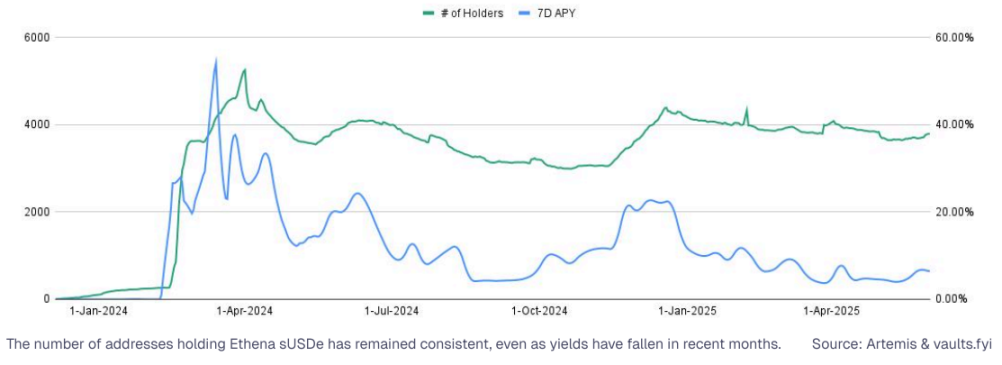
Protocol loyalty also plays an important role. Users of mainstream platforms like Aave often prefer native ecosystem vaults, even if other platforms offer slightly higher rates—similar to traditional finance, where convenience, familiarity, and trust often outweigh minor yield differences. This is particularly evident on Ethena, where despite yields dropping to historic lows, the number of holders remains relatively stable, indicating that yields themselves are not the primary driver of user retention.
Despite the "no yield" risk characteristic of stablecoins, demand for them remains substantial. Platforms that enable permissionless reward accumulation hold significant opportunities in the crypto space, with their value even surpassing that of currently volatile value storage or stablecoins.
2. Better User Experience Enhances Retention Rates: No gas fees, seamless integration, and automation: As DeFi matures, simplifying complex operations is becoming a key driver for improving user retention rates. Products and platforms that can simplify the underlying technical complexities are increasingly favored by both new and existing users.
Account abstraction (ERC-4337) features, such as gasless transactions and one-click deposits, are becoming more prevalent and help make user interactions smoother and more intuitive. These innovations reduce cognitive load and transaction costs, ultimately driving higher capital retention rates and growth.
Cross-Chain Yield Disparities: How Capital Flows
Yield rates for similar assets (especially stablecoins) can vary significantly across different blockchain networks. Data shows that capital opportunistically flows between different ecosystems based on these APY disparities, and the infrastructure to automate such migrations is rapidly improving.
As of June 2025, the average lending yield on Ethereum hovers around 4.8%, while Polygon's yield reaches as high as 5.6%.
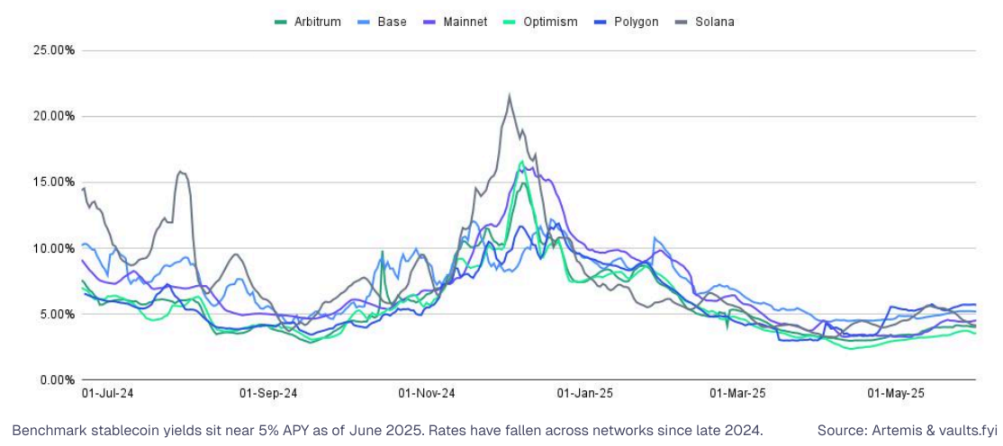
Automated Routing: Applications and aggregator protocols are increasingly capable of cross-chain capital routing to achieve higher annualized yields with minimal user intervention. However, this yield optimization also comes with risks. Bridging assets may expose users to bridging infrastructure risks and slippage risks during periods of low liquidity.
Intent-Centric User Experience: Wallets and dApps are continuously evolving to provide users with simple options like "highest yield" or "best execution." The underlying applications then automatically fulfill these user intents, abstracting complexities such as cross-chain routing, asset swapping, and vault selection.
Capital allocators can leverage deep cross-chain yield analysis to optimize backend stablecoin strategies. By tracking cross-chain annual yield rate differences, capital stickiness, and liquidity depth, these participants can:
- Improve fund management and optimize stablecoin allocation
- Provide competitive yields to users without manual adjustments
- Identify sustainable arbitrage opportunities driven by structural yield gaps
- Monetizing DeFi Yields: Pathways for Fintech Companies and New Banks
DeFi is increasingly being adopted by crypto-native users as well as fintech companies, wallets, and exchanges, becoming "invisible" backend infrastructure. By simplifying the complexities of DeFi, these platforms can embed yields directly into the user experience, enhancing retention, opening new monetization pathways, and improving capital efficiency.
Fintech companies have three main monetization pathways:
1. Integration of Stablecoin Yields: Unlocking new revenue sources: Fintech companies and centralized platforms are increasingly offering stablecoin yields directly within their applications. This is an effective strategy that can:
- Drive net deposit growth
- Increase assets under management (AUM)
- Enhance platform user stickiness and cross-selling potential
Examples:
- Coinbase offers USDC deposit yields, boosting engagement and trading volume within its ecosystem.
- PayPal's PYUSD yield product (approximately 3.7% annual interest rate) attracts funds into Venmo and PayPal wallets, achieving profitability through reserve asset yields and increased payment activity.
- Bitget Wallet's integration with Aave allows users to earn approximately 5% annual interest on USDC and USDT across multiple chains, driving wallet deposits and potential profits through referrals and trading.
These integrations eliminate the complexities of DeFi, allowing users seamless access to yield products while the platform profits through spreads, partner incentives, and increased trading volume. As stablecoin PYUSD gains new demand through yield-centric integrations and institutional adoption beyond traditional DeFi, its supply has reached an all-time high, solidifying its position as a core tool for passive income.
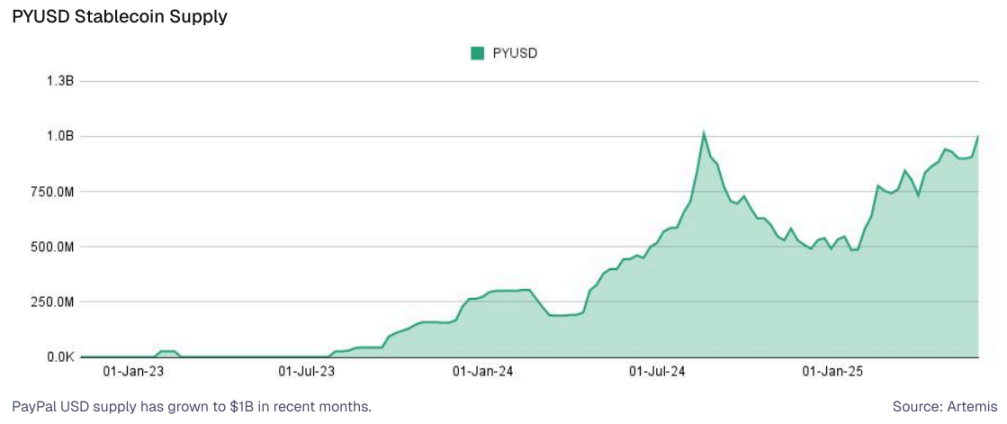
Fintech Opportunities: Integrating yield-generating products or backend DeFi strategies can turn users' idle balances into income sources and deeper engagement. Profit opportunities include net interest margin sharing, premium service fees, and building a more sticky, cost-effective user base that is more willing to accept cross-selling. M0 is a stablecoin infrastructure provider that enables platforms to launch customized stablecoins with built-in yield strategies without fragmenting liquidity or ecosystems. The supply of stablecoins supported by M0 has steadily increased and is now approaching $300 million.
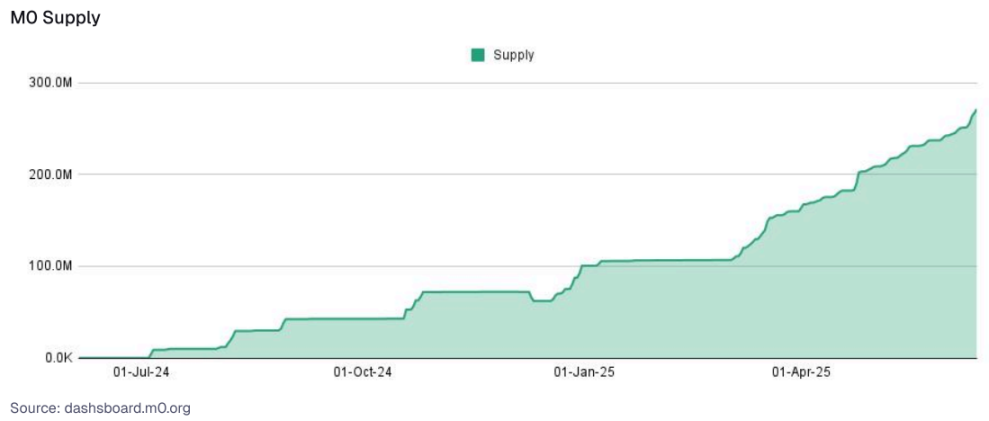
2. Crypto-Collateralized Loans: Seamless credit driven by DeFi. Fintech companies and exchanges now offer non-custodial crypto asset (such as Bitcoin and Ether) collateralized loan services through embedded DeFi protocols.
Example:
Coinbase's on-chain lending integration with Morpho (over $300 million issued as of June 2025) allows Coinbase users to seamlessly borrow against their held BTC, supported by Morpho's backend infrastructure. This model is often referred to as the "DeFi Mullet," enabling:
- Issuance fees
- Interest margin income
- Additional lending activities without the platform assuming direct custodial risks
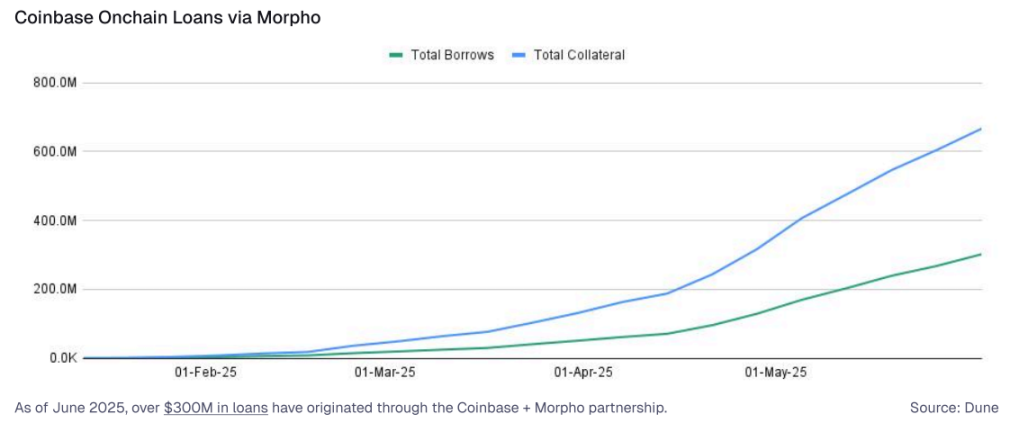
Fintech Opportunities: Fintech companies with a crypto user base (such as Robinhood, Revolut) can adopt similar models to create new fee-based revenue sources by offering stablecoin credit lines or asset-backed loans through licensed on-chain markets.
3. Consumer Yield Products: Embedded, passive yields: DeFi yields are entering consumer-facing financial products in novel and sticky ways:
- Yield-supported debit cards: The concept of "cashback" may evolve into "yield-supported," where stablecoin yields automatically fund rewards or spending balances. Stablecoin spending on yield-supported debit cards has steadily grown to over $1 million per week.

- Automated Yield Wallets: Utilizing account abstraction (ERC-4337) to enable gasless deposits, automatic rebalancing, and programmable savings accounts that generate yields without user intervention.
- Mainstream Examples: Robinhood's idle cash yields, Kraken's USDG rewards, and PayPal's PYUSD savings products all indicate a broader shift towards a frictionless, yield-generating consumer experience.
Among these pathways, platforms that can simplify complexity, reduce friction, and leverage the flexibility of DeFi backends will lead the next wave of stablecoin monetization and user engagement.
Conclusion
The next evolutionary stage of DeFi yields is gradually moving away from the speculative frenzy of the early cycle. In today's environment, DeFi is becoming:
- Simplified: Users will increasingly not need to understand (or care) which specific protocol or complex strategy is behind their asset yields; they will only need to interact with a simplified front end.
- Integrated: DeFi yields will increasingly appear as default options or easily accessible features within existing wallets, exchanges, and mainstream fintech applications.
- Risk-Aware: Institutional partners and insightful users will demand robust risk scoring, comprehensive audits, insurance options, and greater transparency regarding underlying mechanisms.
- Regulated and Interoperable: Protocols will continue to explore regulatory environments, with some opting for permissioned settings or directly collaborating with regulators to meet the needs of institutional and traditional finance clients. Cross-chain interoperability will become smoother.
- Programmable and Modular: As DeFi matures, its core components (lending pools, staking derivatives, automated market makers, and RWA bridges) will increasingly become modular "money Legos," integrated into familiar interfaces while building robust financial solutions behind the scenes.
Platforms thriving in this new era will not merely offer the highest short-term yields. As the field develops and matures, the focus is shifting from chasing fleeting excess returns to building sustainable, value-adding financial infrastructure.
免责声明:本文章仅代表作者个人观点,不代表本平台的立场和观点。本文章仅供信息分享,不构成对任何人的任何投资建议。用户与作者之间的任何争议,与本平台无关。如网页中刊载的文章或图片涉及侵权,请提供相关的权利证明和身份证明发送邮件到support@aicoin.com,本平台相关工作人员将会进行核查。




